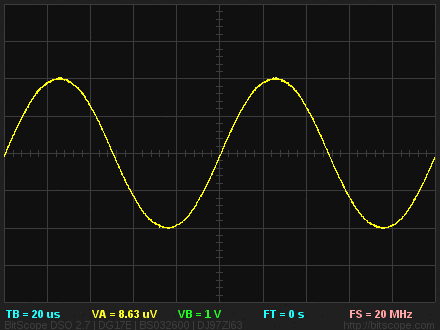
100mV sinusoid waveform at different ranges (hit ESC key to stop)
2013-11-08

100mV sinusoid waveform at different ranges (hit ESC key to stop)
As with any digital oscilloscope, quantization noise is produced when converting analog signals to their digital form.
However, unlike some low cost scopes this is usually not a problem with BitScope because the noise can be minimized using its software controlled analog attenuators and prescalers.
This ensures A/D convertion is optimized.
The remaining quantization noise is very low when compared to the digitized signal and cannot be seen on the display. This animation shows a 100mV sine wave at some varying attenuation and prescale values on BS325.
It's the same signal in each case but the resolution of the waveform shown changes dramatically as the ranges are changed. The smoothest waveform is the one captured with optimum attenuation and prescale. However, when measuring very low level signals or when performing spectrum analysis (as can be done with BitScope), minimizing quantization noise further can be beneficial.
Most digital oscilloscopes start to have problems working with signal below about 10mV but BitScope offers a range of options to improve capture resolution and reduce quantization noise for work at any signal level:
| Function | Description |
| Analog Attenuators | BitScope's analog front end electronics offer a range of software selectable attenuation and gain stages to scale the signal to optimum levels prior to the A/D convertor. It's important to note that unlike some devices which offer switchable attenuation only, BitScope offers gain stages as well. This is very important because it can improve immunity from external noise sources in all ranges. |
| Analog Prescalers | Some models like BS445 and BS325 also offer software selectable analog prescalers which increase the gain available for work with lower signal levels without reducing the A/D capture resolution. Prescalers can also be used to compensate for higher levels of probe attenuation, for example when measuring high impedance signal sources. |
| Resolution Enhancement | All BitScopes have large capture buffers compared to the 1k sample buffer typically found in other digital scopes. From BS10 with 12k buffers to BS325 with up to 512k, these large buffers allow BitScope to improve sample resolution after the signal has been captured, from its native (8 bits) up to 12 bits or more in some cases. |
| A/D Macro Mode | For lower bandwidth work some models like BS10 offer Macro Mode which applies a bandlimiting filter and uses a 12 bit A/D convertor instead of its wide band 8 bit one. |
| Switchable Filters | Some noise sources that can affect capture resolution are at different (higher) frequencies than the signal of interest. In these cases a switchable RF filter is available in some models to remove this interference prior to conversion. |
| Input Offsets | Many digital oscilloscopes have problems when looking at small signals sitting on a large DC bias or on a large but much lower frequency bias signal. AC coupling can help for a DC bias but dynamically controlled analog front end input offsets are really required to shift the small signal of interest to zero to maximize capture resolution. |
| Oscilloscope Probes | All BitScopes that have BNC inputs are compatible with a wide range of standard oscilloscope probes. These offer attenuation ranges for work with higher level signals and are designed to maximize noise rejection. |
Most of these features are activated automatically when using BitScope software such as BitScope DSO or Meter. Others may be applied manually or with custom software written with the BitScope Library. When combined they allow BitScope to be used for high resolution analog waveform capture, analysis and data acquisition. We'll write more about how to minimize noise and maximize waveform resolution in future posts. Stay tuned!